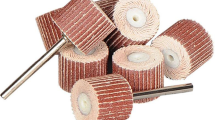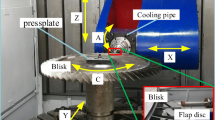Abstract
The diminishing of the surface roughness of a metallic part can be performed by using various finishing methods, polishing by means of abrasive flap wheels being one of them. There are several factors that influence the roughness of surfaces finished by means of abrasive flap wheels. When polishing external cylindrical surfaces by means of abrasive flap wheels, the surface roughness can be changed more easily if the following elements are modified: the peripheral speed of the workpiece and of the abrasive flap wheel, the speed of the longitudinal feed, and the grit size of the abrasive material. Experimental research has allowed for the establishment of power-type functions which highlight the influence exerted by the above-mentioned factors on the size of the surface roughness parameters R a , RS, RSm, Rku. Analyses of the experimental results have shown that, in the case of the R a roughness parameter, from among the range of interactions of orders 2 and 3, only the interaction between the rotation speed of the abrasive flap wheel and the speed of the longitudinal feed seems to be significant.















Similar content being viewed by others
References
Yan BH, Tsai FC, Sun LW, Hsu RT (2008) Abrasive jet polishing on SKD61 mold steel using SiC coated with wax. J Mater Process Technol 208(103):318–329
Tsai FC, Yan BH, Kuan CY, Huang FY (2008) A Taguchi and experimental investigation into the optimal processing conditions for the abrasive jet polishing of SKD61 mold steel. Int J Mach Tools Manuf 48(7–8):932–945
Barge M, Rech J, Hamdi H, Bergheau JM (2008) Experimental study of abrasive process. Wear 264(5–6):382–388
Huang C, Chiovelli S, Minev P, Luo J, Nandakumar K (2008) A comprehensive phenomenological model for erosion of materials in jet flow. Powder Technol 187:273–279
Azmir MA, Ahsan AK, Rahmah A (2009) Effect of abrasive water jet machining parameters on aramid fibre reinforced plastics composite. Int J Mater Form 2:37–44
Davidson DA (2007) Green mass finishing with dry abrasive and polishing media: novel finishing process allows refined surface edge effects while avoiding conventional wet-waste discharge. Met Finish 105(5):45–48
Sundararajan G (1991) A comprehensive model for the solid particle erosion of ductile materials. Wear 149:111–127
Dikavar M, Agarwal VK, Singh SN (2005) Effect of the material surface hardness on the erosion of AISI316. Wear 259:110–117
Flap Wheels. Available at: http://www.weldinggear.co.uk/Abrasives/Flap-Wheels/. Accessed: 10.12.2008
Use a soft touch for a finer finish. Available at: http://www.contractortoolsandsupplies.com/past/abrasives_and_brushes/SoftTouch.htm. Accessed: 10.12.2007
Gdalevici AI (1990) Finishing with abrasive flaps (in Russian). Mashinostroenie, Moscow
Tool and Manufacturing Engineers Handbook. Knowledge Base. (1998) Society of Manufacturing Engineering
Kalpakjian S, Schmid S (2001) Manufacturing engineering and technology. Prentice Hall International, Upper Saddle River
Marty C, Linares JM (1999) Procédés de fabrication. Hermès Science, Paris
Hof P (2006) FEPA. Federation of European Producers of Abrasives. Aluminum Oxide & Silicon Carbide Grains. Available at: http://www.fepa-abrasives.org/DesktopDefault.aspx?portalname=www.fepa-abrasives.org&language=E&folderindex=0&folderid=3&headingindex=5&headingid=80&tabindex=0&tabid=272. Accessed: 20.12.2007
Creţu G (1992) Fundamentals of the experimental research. Handbook for the laboratory activities (in Romanian). Institutul Politehnic, Iasi
Pillet M (1994) Introduction aux plans d’expériences par la méthode Taguchi. Les Éditions d’Organisation, Paris
Acknowledgements
The research was done within project no. ID_625, financed by the National Council of Scientific Research in Higher Education (Romania).
Author information
Authors and Affiliations
Corresponding author
Rights and permissions
About this article
Cite this article
Slătineanu, L., Coteaţă, M., Dodun, O. et al. Some considerations regarding finishing by abrasive flap wheels. Int J Mater Form 3, 123–134 (2010). https://doi.org/10.1007/s12289-009-0665-8
Received:
Accepted:
Published:
Issue Date:
DOI: https://doi.org/10.1007/s12289-009-0665-8




